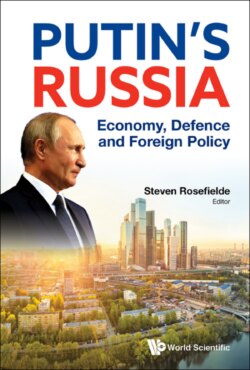Читать книгу Putin's Russia - Группа авторов - Страница 22
На сайте Литреса книга снята с продажи.
Introduction
ОглавлениеRussia is in many ways a special country, which may lead us to believe that regular political and economic analyses are not applicable. This may certainly be true in some regards, but there are still many dimensions that are as relevant in Russia as they are in most other countries. One such dimension is that generating growth and prosperity in a stable macroeconomic environment is something both the leadership and population at large value.1 However, looking at approval ratings and GDP growth for President Putin does not immediately tell this story.
In the left panel of Figure 1, Putin’s approval rating in the Levada Center’s surveys is negatively correlated with GDP growth. It is rather unexpected and unusual that a country’s leader becomes more popular when growth is lower. A closer look at the data reveals that the negative correlation is generated by three distinct periods; the first year is when Putin was still relatively unknown at the same time as Russia’s growth rates were the highest since the break-up of the Soviet Union due to the rebound after the 1998 crisis; then Russian growth was hit by the global financial crisis in 2008/2009; and then finally, there is the period of Putin’s approval getting a significant boost following the annexation of Crimea and period of sanctions and counter-sanctions in a time of very poor growth.
Figure 1:GDP growth and approval ratings of Putin.
Source: Levada Center and Federal Statistics service.
Removing these exceptional periods from the left panel in Figure 1, we get the right panel that shows what we can think of as more “normal” quarters of economic and political developments in Russia. All of a sudden, the approval rating for Putin lines up very well with quarterly growth rates and the correlation between the two variables goes from a negative 0.3 in the left panel to a positive 0.7 in the right panel. In other words, Putin’s popularity increases with higher growth like in most other countries. The caveat is of course that when growth turns out to be less than satisfactory, there are other ways for a Russian president to boost his approval ratings.
Again, Russia may be different in the sense that approval ratings and the probability of regime change are less clearly connected than in Western democracies, but it is hard to think that low popularity ratings would not affect the probability of some type of popular or elite movements that challenge the president. Therefore, generating high and sustainable growth is one of the central tools for a president to stay in power in Russia as well. The fundamental question posed in the chapter is whether capital flows and foreign direct investments can help generate more productive domestic investments that in turn lead to higher sustainable growth. In order to analyse the economic–political nexus of growth and popularity ratings, the chapter starts by investigating how Russian growth compares with peer groups and to what extent a regular growth model can be used to understand growth in Russia. The analysis suggests that this is the case and then looks at investments, capital flows and uncertainty to disentangle external factors and domestic policies that have contributed to the developments we have seen in the Russian economy.
What sets this analysis apart from much of the other literature on Russian growth is the focus on uncertainty and the importance of specific policy actions rather than institutions more generally. It also highlights how a serious economic reform programme will contribute to regime stability in the longer run, while external conflicts only have a short-run popularity effect that carries a high price in terms of lost growth opportunities and lower long-term approval ratings.
